Overview
GCF is committed to ensuring that our activities complement those of other funds, and that together we have a coherent approach to supporting the climate ambitions of developing countries.
This commitment is set out in our Governing Instrument (para 33).
GCF has a Complementarity Framework which sets out our approach.
Complementarity refers to synergies among the various climate funds’ activities in similar sectors and themes (adaptation or mitigation), and even across regions of similar characteristics, with the aim of scaling up transformative actions.
Coherence is about using country programming to seek alignment with Nationally Determined Contributions (NDCs) and National Adaptation Plans (NAPs).
GCF works with the Adaptation Fund (AF), the Climate Investment Funds (CIF), and the Global Environment Facility (GEF) to maximise the impact of our activities.
On 14 November 2024, at COP29 in Baku, the Heads of the Multilateral Climate Funds made a joint statement updating on progress on complementarity and coherence since the COP28 joint declaration, and announcing the launch of the Climate Project Explorer.
As part of its efforts in this area, GCF and GEF have developed a Long Term Vision on Complementarity and Collaboration.
The full document is available here.
On 3 November 2021 - Finance Day at COP26, GCF adopted a joint statement with the Adaptation Fund, CIF and GEF.
[COP26] Long-term vision (LTV) on complementarity, coherence, and collaboration between GCF and GEF
[COP27] GCF and GEF synergies: Coherence and complementarity in catalysing private sector action
[COP27] GCF and GEF – Long term vision for the future
Resources

GCF in Brief: Complementarity and coherence
01 Dec 2021
GCF is committed to ensuring that our activities complement those of other funds, and that together we have a coherent approach to supporting the climate ambitions of developing countries. Complementarity refers to synergies among the various climate funds’ activities in similar sectors and themes (adaptation or mitigation), and even across regions of similar characteristics, with the aim of scaling up transformative actions. Coherence is about using country programming to seek alignment with nationally determined Contributions (ndCs) and national adaptation plans (naps).

Towards a Long-Term Vision on Complementarity GEF and GCF Collaboration
03 Nov 2021
This document presents a Long-Term Vision on Complementarity and Coherence collaboration between the Green Climate Fund (GCF) and the Global Environment Facility (GEF), herein after referred to as LTV. This new vision aims to build on the Pilot Coordinated Engagement exercise the GCF and GEF have been carrying out since 2018, and further define specific areas of cooperation, where complementarity of action might be most efficient and effective, and possible modalities to generate long-lasting outcomes and outputs in climate change adaptation and mitigation.
Case studies

Protecting Bhutan’s forests
GCF has joined the World Wildlife Fund (WWF), the royal Government of Bhutan and other partners in the Bhutan for Life programme. this programme builds on the recommendations developed by the GEF evaluation of Bhutan’s REDD+ program. the innovative financial structure helps Bhutan’s goal to keep 60 percent of its area under forest cover through a network of forested protected areas. the funding is initially capitalised with a USd 43 million transition fund by donors, including GCF, combined with a contribution of USd 75 million by Bhutan’s government over 14 years from 2018. this programme is helping Bhutan remain “carbon negative,” as its forests sequester four times more than its annual emissions. See project details >

Developing pathways towards a low-emission industrial sector
This programme is GCF’s first at-scale investment for the industrial sector to promote uptake of low-carbon industrial technologies. it builds on a ‘high impact loans’ model initially tested through a USD 53 million project funded by CIF. Working with the European Bank for Reconstruction and Development (EBRD), the programme has been designed to facilitate a transformational shift within energy-intensive industries, agribusinesses, and the mining sector in Armenia, Jordan, Kazakhstan, Morocco, Serbia, Tunisia, and Uzbekistan. it introduces an innovative concessional financing mechanism to address barriers in accessing high-impact climate technologies, in addition to promoting sustainable corporate climate governance and management practices. See project details >

Strengthening Antigua and Barbuda’s climate response
Through this project, GCF capitalises on a baseline investment financed by a USD 1.5 million-grant from the Adaptation Fund. The project will climate-proof critical public service and community buildings to improve resilience to, and recovery from, extreme climate events such as hurricanes. This includes upgrading existing infrastructures to withstand harsh and strong winds, decentralising power and water supplies, establishing evacuation shelters, and enhancing capacities of responders. This approach will shift the country’s building sector away from reactive development — involving costly recovery actions after an extreme climate event — towards a more proactive approach in which buildings are adapted to withstand the increased frequency of high-intensity hurricanes. See project details >

